To use your Raspberry Pi as a hotspot or access point is actually straightforward. You will find many guides that talk about lengthy manual configurations via command line with hostapd and so on. But it is actually much easier if you use RaspAP. Not only is the installation much easier – you also get a graphical interface (GUI) to manage your Wi-Fi hotspot or access point. Once this is done, you only need a few simple additional steps to turn your Raspberry Pi into a VPN router. RaspAP does work Raspbian Buster that I am using in this tutorial.
Quick guide how to use your Raspberry Pi as a VPN router
To use your Raspberry Pi as a VPN router seems to be more complicated that it actually is. In a nutshell those are the steps required:
- Install Raspbian Buster
Install Raspbian Buster onto your Raspberry Pi. I am using Raspbian Light as a graphical interface is not necessary.

- Get RaspAP
Get RaspAP up and running. This turns your Raspberry Pi into a Wi-Fi hotspot or access point.
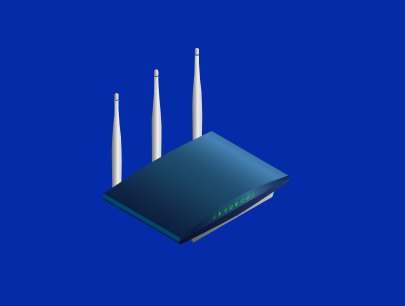
- Get a VPN
Get a VPN that runs on Raspbian and ideally one with a command line client. I’m using NordVPN as it has one of the most versatile Linux clients on the market. You can try NordVPN as the service offers a 30-day money-back-guarantee. It is undoubtedly one of the best VPNs on the market. Try NordVPN 30 days without risk!*

- Install the VPN
Install the VPN on Rasbian and connect to a server.

- Enjoy your VPN router!

Quick Guide from the comments (thanks!)
Software changes and sometimes it gets easier. Thanks for this quick guide from a recent installation:
- Update the system and set Wi-Fi country (https://raspap.com/#manual-installation Prerequisites)
- Get NordVPN* and install the client (you might need to reboot here)
- Configure the client:
- Log in
- Whitelist ports 22, 67-68 (
nordvpn whitelist add portornordvpn whitelist add ports) - Switch to nordlynx (
nordvpn set technology nordlynx) - Deactivate NordVPN Firewall:
nordvpn set firewall off - Install RaspAP
- Configure RaspAP:
- Change SSID, password etc.
- Use NordVPN DNS addresses (103.86.96.100 and 103.86.99.100) in RaspAP to avoid leaks
- Restart
That is pretty straightforward and really worth a try.
Update: With Linux client 3.9.0 you can set the firewall on or off (nordvpn set firewall on/off). That might be helpful as well for your router.
If your connection does freeze once in a while – maybe that script helps:
! /bin/bash
PING="/bin/ping -q -c1"
HOST=example.com
${PING} ${HOST}
if [ $? -ne 0 ]; then
/usr/bin/systemctl restart nordvpnd.service
sleep 45
/usr/sbin/runuser -l pi -c 'nordvpn c UK'
fiPlease check HOST in case you want to ping something else. Also change the user after runuser -l – in my case that is pi because the script runs on a Raspberry Pi läuft. The script starts the MordVPN daemon new if the ping fails – after a certain waiting time it connects to the UK. Of course, you can change that as well.
Prerequisites for using RaspAP on a Raspberry Pi
For this to work, you need a Raspberry Pi with two network cards. One of them must logically be a wireless network card (Wi-Fi) because it serves as a hotspot or access point. The other network card could theoretically also be a wireless network card, but better is the integrated Ethernet interface. The Raspberry Pi 4 shown below also works, of course.
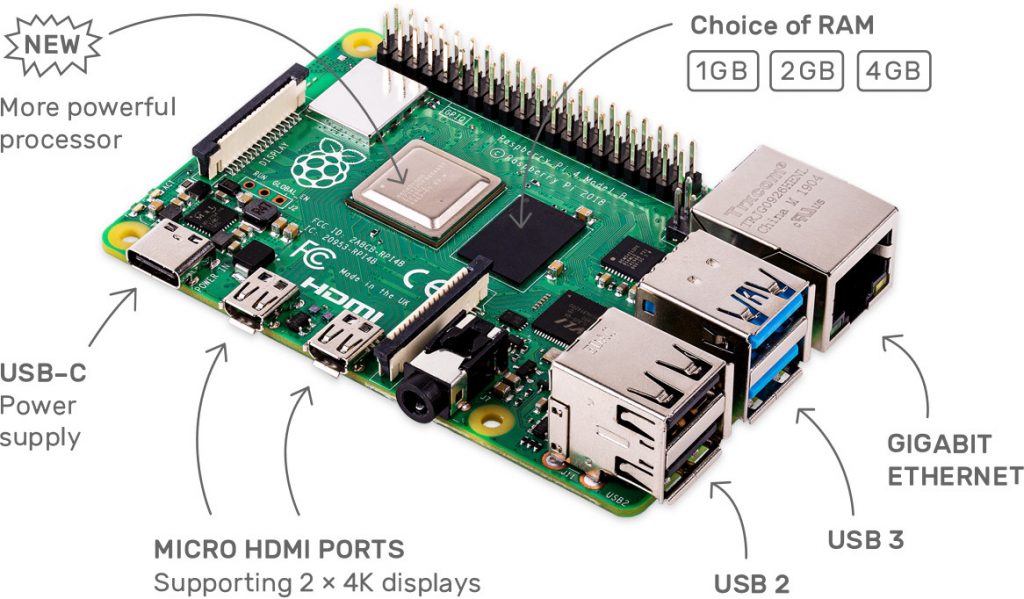
Let’s put it this way: The easiest way is to use a Raspberry Pi that already has an Ethernet and wireless interface. The Pi expert knows immediately that we are talking about the Pi 3 B upwards. For Pis without an integrated Wi-Fi card, it’s best to use a cheap, compatible USB network interface. I have had very good experiences with the Edimax. The cost is about 7 Euro.
Logically you need a suitable power supply, a microSD card and so on. With the microSD card a relatively small one is enough, but you hardly get anything under 16 GB these days. They only cost about 10 Euro — affordable so. You also need a network cable if you want to follow my instructions.
Mouse, keyboard and screen are not necessary! As already mentioned, I use Raspbian Buster as my operating system. But the lite version is enough for me, and we configure the operating system so that you can access it immediately via SSH.
Which Raspberry Pi should I use for the hotspot?
That’s a good question. The new Raspberry Pi 4 is powerful and works very well but it needs more power than its predecessors. If you don’t want to buy an additional network card, you can use both Pi 3 B and Pi 3+ B. The most energy saving would probably be a Raspberry Pi Zero W, if you extend it with an Ethernet interface. It might not powerful enough for a task like that but I didn’t test it to be honest.
My scenario
I tested RaspAP with a Raspberry Pi 3+ and used the integrated network interfaces. The Ethernet interface was connected to the router. This is my gateway to the Internet.
Install Raspbian Buster Lite on the microSD card
In the download area of the project page you can find the image for Raspbian Buster Lite. It has 426 MB and should be downloaded relatively fast.
Update: The Raspberry Pi Imager is a nice option to install Raspberry Pi OS Lite.
As soon as you have the image, you can upload it to your microSD card. I use Etcher because it’s the most convenient way. But also dd or other options are possible.

Depending on the OS and speed of the microSD card, the installation may take a while. Once the image has been installed, mount the microSD card again because we immediately prepare the operating system for remote access.
SSH access from the beginning
Simply create an empty ssh file on the boot partition without an extension. This is very easy under Linux. For example, the command touch ssh is sufficient. The boot partition looks like this afterwards:

If the file ssh exists, Raspbian activates the SSH server at system startup and you can access the operating system via Secure Shell. This way you don’t need a screen, keyboard or mouse. If you connect the Pi to the router via the Ethernet network cable, no further configuration is necessary because the Pi is assigned an IP address by the DHCP server of the router.
It gets a little more complicated if there is no DHCP server in the network or if you want to use a wireless network card as gateway. As already mentioned, the Pi in my case uses a network cable.
Determining the IP address of the pi
If you have started the Raspberry Pi, then you find out the IP address. Usually it is enough to check the router. Most routers tell you which devices are within the network and which IP addresses have been assigned.
I like to assign static IP addresses to such devices. Normally, you can assign an IP address to a MAC address in the DHCP server of the router. This way the Raspberry Pi always gets the same IP address and you don’t have to configure it within the operating system. Another advantage of this method is that the DHCP server does not assign the IP address to any other device. DNS servers and so on are also assigned to the PI by the router.
As soon as you know the IP address, remote access should be possible. In my case, the IP address was 192.168.1.2. By default, the name and password of the SSH access on a Pi are: pi and raspberry:
ssh pi@192.168.1.2On first access you have to confirm that access is really granted.
As soon as you are logged on to the Raspberry Pi, you should change the password for the user pi immediately, otherwise everyone in the same network can get access to your device. Either you use the command passwd or you open the Pi configuration:
sudo raspi-configThis opens the command line configuration tool.
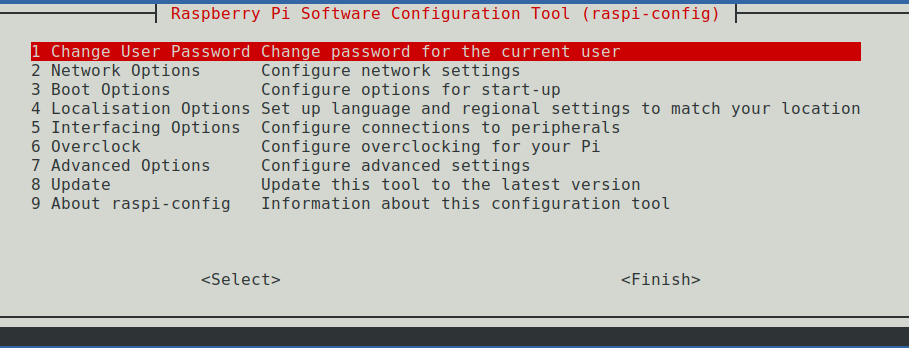
Because the configuration tool is already open, you can also set the country settings right away — if necessary:
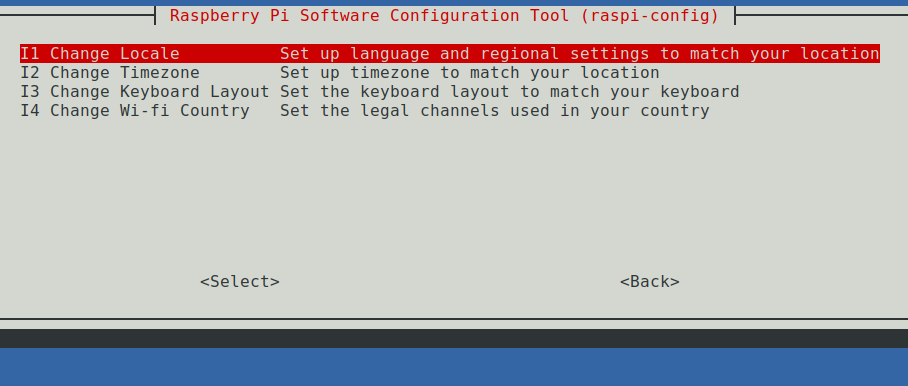
Update Raspbian Buster straight away
It is also advisable to update the system. An upgrade never hurts and Raspbian know the drill anyway:
sudo apt update
sudo apt dist-upgrade
sudo rebootNow you need to restart the device before you continue. After that, you have to reconnect to the Pi via SSH. Once the operating system Raspbian Buster is updated and the system restarted, we can convert the Pi into hotspot with RaspAP.
Installing RaspAP – step by step
Now we install RaspAP. The project page can be found at raspap.com. We don’t have to visit it directly, but it doesn’t hurt to know the source. If you are logged in on your Pi, you install RaspAP just like that:
wget -q https://git.io/voEUQ -O /tmp/raspap && bash /tmp/raspapThe installation is starting now:

During the installation I had to answer a few questions, which I answered with Yes: http-cookies -> Yes – Control service -> Yes

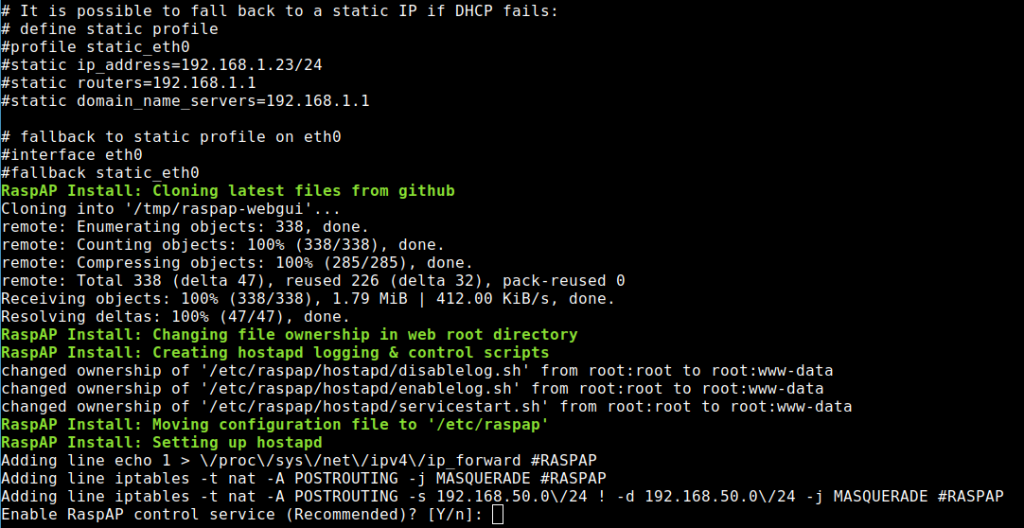
Furthermore, the system asks if you want to install the ad blocker and the OpenVPN client. I installed both. The functions don’t hurt, and you don’t have to use them if you don’t want to.

That’s all and it! RaspAP is installed on your system!

As you can see in the screenshot, the system wants to restart. So, we do RaspAP the favor.
IP address of RaspAP or the hotspot
By default, the hotspot gateway has the IP address 10.3.141.1. This is fine because it does not interfere with the other 192.168.1.x network. I have not changed anything at this point. As DHCP area RaspAP is preconfigured with 10.3.141.50 to 10.3.141.255.
By default RaspAP has the name raspi-webgui as SSID and the password is ChangeMe. The hotspot or access point is now ready for use and you can log in. You can change the password and SSID in the web GUI if you want.
Here is what you need to know as the default settings:
- IP address: 10.3.141.1
- Username: admin
- Password: secret
- DHCP range: 10.3.141.50 — 10.3.141.255
- SSID: raspi-webgui
- Password: ChangeMe
RaspAP’s web gui
You configure your hotspot completely via your browser. Either you log in to the hotspot and use URL 10.3.141.1 or you are in another network and open the admin interface with (in my case) 192.168.1.2.
By default, you log in with admin and secret. At this point I would advise you to change all passwords first and adapt the hotspot to your needs. You can also configure the DHCP server via the web GUI. Here are some screenshots, how it looks like.
Under Configure hotspot -> Basic you can configure how the Pi hotspot should be found. In my case I changed it to pi-hotspot for example.

That works and I can connect:

A ping to my website confirms to me that I can access the internet via RaspAP.
You change the password for the hotspot under Configure hotspot -> Security. Maybe you want to change Security type to WPA + WPA2.

The settings or the DHCP server are under Configure DHCP Server:

In most cases you don’t have to change these settings.
More settings for RaspAP
The hotspot software also offers a console.

However, it is only of limited use, since it does not give you root access and you cannot switch with sudo. I would leave that as is and manage the operating system exclusively via SSH.
You don’t like the theme? Change it! There are a few other options like a terminal theme.

if you open the Dashboard you always see the most important settings straight away.

As you can see, the installation of RaspAP is simple. But basic knowledge of networks in general is helpful.
Changing the DNS server of RaspAP
Update: In more recent installations of RaspAP you can set the DNS addresses within the GUI. There is no need to do it via command line if you prefer a graphical interface.
By default, RaspAP uses 1.1.1.1 (Cloudflare) and 8.8.8.8 (Google) as DNS servers. The DNS servers are stored in the file /etc/dhcpcd.conf.

If you want to use your own, change this here. Maybe you have the adblocker Pi-Hole in your network and RaspAP should use it as DNS server. FreeDNS is also a nice alternative.
Your Raspberry Pi is now a working Wi-Fi hotspot or access point. Now we will turn it into a VPN router. Did you already register with NordVPN?
Once you have RaspAP installed and running, take the next step and build your own VPN router. These are just a few additional steps. In this article, I’ll explain step-by-step how it works.
VPN router only counts as one device!
Many VPN providers allow the use on a router and your Raspberry Pi will only count as 1 device or 1 connection, no matter how many smartphones, tablets and computers are connected to it.
That is a nice advantage if you ask me. Furthermore, you can use it as a Wi-Fi access point for devices where no VPN client does exist for. Connect your Chromecast to the VPN router, your Smart TV, your gaming console and so on.
A VPN router is also an excellent choice if you want to connect a Kodi device to it. LibreELEC is a very nice operating system if you want to install Kodi on a Raspberry Pi. But there is no easy way to use VPN apps for Kodi or LibreELEC. However, you could connect your LibreELEC device to your VPN router and circumvent the issue.
Don’t forget the rise of IoT (Internet of Service) devices! A lot of them will connect to Wi-Fi but have very limited options to install additional software. For a lot of those devices the only option to use a VPN is a VPN router.
If your Raspberry Pi acts as a VPN router you don’t need to install a client on every device you want to use the VPN. Just connect the Pi to the server or country you want to use and connect the devices to the Pi. It really is that simple.
So let’s get started and turn the Raspberry Pi into a VPN router.
Do all VPNs work?
In theory any provider that provides ovpn files works. This allows you to connect to the provider manually via the OpenVPN protocol. First, I’ll show you how to use the Linux client from NordVPN to build a VPN router as this is the most convenient way. After that I’ll tell you how it works with a normal OpenVPN connection.
Install NordVPN on the Raspberry Pi and turn it into a VPN router
If you want to follow my instructions, you need a subscription to NordVPN. It’s great that the VPN provider offers a 30-day money-back-guarantee. You can first try out whether your Raspberry Pi runs properly as a VPN router and if not, you simply demand your money back. The provider doesn’t ask stupid questions and usually refunds rapidly.
My Raspberry Pi runs headless — without peripheral devices like screen, mouse and keyboard. I log on to the device via SSH. After that, I download the deb file from NordVPN.
wget -c https://repo.nordvpn.com/deb/nordvpn/debian/pool/main/nordvpn-release_1.0.0_all.debNow you install the file via shell:
sudo dpkg -i nordvpn-release_1.0.0_all.debThe deb file is basically only setting up the repository. You have to update the package information and after that you install the Linux client of NordVPN.
sudo apt update
sudo apt install nordvpnIt looks like this:

Setting up the NordVPN client
The first step is to log on to the client with your access data from NordVPN:
nordvpn loginNow the client asks for username and password.
The Linux client of NordVPN provides a so-called Whitelist. I put port 22 here to be on the safe side so that SSH access is possible in any case.
nordvpn whitelist add port 22You can review the settings with the following command:
nordvpn settingsQuick connect to NordVPN work like that:
nordvpn cImportant! Now the Raspberry Pi does not work anymore as a hotspot or access point! If you are still connected to the Pi hotspot, you won’t feel a difference. But new connections are impossible — so we need to fix that.
NordVPN changes iptables on our VPN router (if the firewall is on)
The reason for the behaviour is that the Linux client of NordVPN modifies iptables — if the firewall is not deactivated. I recommend deactivating the firewall because it saves a lot of hassle.
If you want to proceed with the firewall active here are a few hints and tips. You can view the current rules with that command:
sudo iptables -SIf you do that before and after a connection to the VPN you see what I mean:

If I want to connect to the Pi Hotspot now, I don’t even get an IP address anymore. That’s why I execute the following two commands and the hotspot assigns me an IP address again and works as designed:
sudo iptables -P INPUT ACCEPT
sudo iptables -P OUTPUT ACCEPTHowever, the device does not route my traffic to the Internet. Therefore, the following iptables entries are necessary.
sudo iptables -t nat -A POSTROUTING -o tun0 -j MASQUERADE
sudo iptables -A FORWARD -i tun0 -o wlan0 -m state --state RELATED,ESTABLISHED -j ACCEPT
sudo iptables -A FORWARD -i wlan0 -o tun0 -j ACCEPTNow everything works as designed — but there still is a little catch.
Making the settings for VPN router permanent
With the commands shown above, the settings are only temporary. They are lost as soon as you restart the Raspberry Pi. The first two commands will also be overwritten when you connect to another NordVPN server.
Now there are several options to make the settings permanent. Of course, I want NordVPN to connect to the startup immediately. A cronjob via /etc/crontab is an option. For this, I first create a script file, which I simply call nordvpn.sh.
nano nordvpn.shI put the following lines into it:

I need the line sleep 30 because the NordVPN daemon needs a bit after the system starts and the command
nordvpn c UKwould not be executed. As you can imagine, that command would connect me to a server in the UK. In this case you would be able to stream BBC iPlayer for example.
I tried with sleep 20 and sometimes it worked — sometimes it didn’t. So, I opted in for a 30-second wait and that is OK. The file need to be executable as well.
chmod +x nordvpn.shNow I put the following line at the end of the file /etc/crontab:
@reboot pi /home/pi/nordvpn.shIt looks like this now:

Tip: If you want to execute the script via /etc/rc.local be aware that the user pi has to run the command. The login data of NordVPN are stored per user and that is in this case pi. Per default the user root will be in charge of the file rc.local!
su pi -c '/path/to/script'The above command would execute the file as user pi.
Connect automatically to the VPN – VPN router has to be reconfigured
It is possible that the connection to the VPN fails – that happens once in a while. In this case, the data traffic of your device would no longer be routed through the VPN. We want the VPN to reconnect automatically in case of a connection failure. You can do this with the command:
nordvpn set autoconnect onThis would also automatically connect the VPN client when the device is restarted. However, the iptables entries are missing and therefore I run my script once the system starts.
You can also specify a country with autoconnect:
nordvpn set autoconnect enabled UKThe software would connect you automatically to the UK.
What happens if the connection goes down?
I disconnected the router from the Internet (pulled the cable) and waited a minute to see what happens. After plugging the cable back in, the DSL line first synchronized and shortly afterwards the Internet connection was restored.
My VPN router still worked as before. If you want to be on the safe side, you could run another mini script every minute as a cronjob. For example, call the crontab as user pi:
crontab -eand use a line like that:
* * * * * /home/pi/nordvpn-minute.sh > /dev/null 2>&1If everything is fine, the script has no effect. If the VPN connection is established, it will not be re-established. In case the iptables settings are correct, the system will not overwrite them. The output of the cronjob is transferred to /dev/null (digital black hole).

The reason for the script is clear. If the VPN daemon connects completely new, it sets INPUT and OUTPUT to DROP and our hotspot doesn’t work anymore.

Yeah, it’s not the most elegant method but it seems to work reliably. I have tried it. If you run the command via cronjob, you don’t have to worry about it at startup. At the latest one minute after the NordVPN daemon is available, a connection to the VPN is established.
You may even want the VPN router to stop working if it fails. This would also be a kind of kill switch and you can see what went wrong.
In the end, you’ll have to experiment a bit to see which solution works best for you. But with a little patience, trial and error, your VPN router will be up and running in no time.
Tip: If your client cannot connect to the Wi-Fi hotspot with the VPN activated try to add ports 68 and 69 UDP (DHCP) to the whitelist.
nordvpn whitelist add ports 68 69 protocol UDPThen try again — maybe with a restart in between. As mentioned at the start you can also try to deactivate the firewall (from NordVPN Linux client 3.9.0 on:
nordvpn set firewall on/offA few thoughts regarding the VPN router
You may want to restart your VPN router once a day. You could also do that with a cronjob.
If you disconnect the VPN connection and then log in again, you might get a faster server assigned.
A web GUI where you can enter the country you want to connect to would be pretty fancy. Maybe that is a project you want to do afterwards. Shouldn’t be too complicated to be honest but you need a web server installed.
OpenVPN – connect the VPN router via ovpn file
Most good VPN providers provide ovpn files so you can set up an OpenVPN connection manually. Clients have the advantage that you can change the country more conveniently. The client of NordVPN has another advantage. You can use CyberSec and the obfuscated servers. CyberSec is a neat feature because it blocks ads, tracker, and malware. Every device that is connected to the VPN router will benefit from CyberSec! The obfuscated servers also known as stealth servers are nice in countries with strong censorship. They might help to beat geoblocking from streaming providers as well.
A connection via ovpn file has the advantage that the hotspot works as designed without any problems. The command does not add any new iptables rules at all.
Install OpenVPN
For this to work, you have to install OpenVPN on the Raspberry Pi:
sudo apt install openvpnThen get the ovpn file you want. To stick to the NordVPN example, you will find the OpenVPN configuration files for all servers on this page. The list is quite long and if you’re looking for a particular server, the page with all the servers is more convenient.

Just with that file you already can establish a connection. If you installed the OpenVPN client for RaspAP you can use the backend to import your .ovpn file.

Of course, you can do this manually.
sudo openvpn uk1418.nordvpn.com.udp.ovpn &Now you have to enter Username and Password. That should be the case with most VPN providers.

It’s OK for a test but you can’t connect automatically like that. If you want to do that, you need a file e.g. auth.txt. It hast to be in the same directory as the ovpn file.
The first line holds the Username and the second line is the Password!
Then enter or modify the following line in your ovpn file: auth-user-pass auth.txt

If you use the OpenVPN command from above again, your system automatically logs on to the VPN server. Now you can also automate the process.
Be careful! DNS leak!
However, you will continue to use the DNS servers of the hotspot. If you have not changed them, they are the 1.1.1.1 (Cloudflare) and 8.8.8.8 (Google) defined by RaspAP. You can find them in the file /etc/dhcpcd.conf. The static IP address of wlan0 is stored there as well by the way.
This is basically a DNS leak. With my solution and the client of NordVPN I also use the DNS servers of the VPN provider and therefore my DNS queries are anonymous.
Of course, you can also solve this differently. Maybe you have a Pi-hole in the network anyway and use it as DNS server. There are many possibilities here, including FreeDNS. I just wanted to point out the potential DNS leak here.
In the DHCP configuration of your RaspAP you can also define what DNS servers the clients should get. Use the DNS servers of NordVPN to avoid leaks: 103.86.96.100 and 103.86.99.100
Does that also work with NordLynx (WireGuard)?
If you have installed a current client, NordLynx also has a uniform network interface. It is called nordlynx. Here is a screenshot:

Now I can make the corresponding routing entries. WireGuard is slightly faster than OpenVPN and it’s your decision what you want to use. The solution with OpenVPN as VPN router works very well and that is not a slow either.

However, the solution for the network interface nordlynx for iptables looks like this:
sudo iptables -t nat -A POSTROUTING -o nordlynx -j MASQUERADE
sudo iptables -A FORWARD -i nordlynx -o wlan0 -m state --state RELATED,ESTABLISHED -j ACCEPT
sudo iptables -A FORWARD -i wlan0 -o nordlynx -j ACCEPTWould you like to make your own VPN router now? It’s really not difficult and NordVPN is a good partner for it.
As I said, most reputable VPN providers should provide the resources for your project. I like NordVPN because I can use the command line client under Linux. But the provider also provides a great Android client. It is one of the most user-friendly providers on the market.
With NordVPN you can use up to 6 devices simultaneously. Because a VPN router is allowed, your Raspberry Pi counts as 1 device, no matter how many others are connected to it.
The VPN provider also allows torrent downloads and P2P connections / file sharing.
rbaoc
says:Thank you for your reply. Sorry about this late, I just though there will be somehow notification about the reply xD
I would like to turn Pi a secure router, so of course, use Pi-hole for a whole network. The instruction on pi-hole.net doesnt work with VPN gateway mode. I am still looking for a solution.
Cezar
says:The default protocol chosen by NordVPN’s Linux software is OpenVPN. To switch to NordLynx (built on WiredGuard), execute:
nordvpn set technology NordLynx
In my case, the corrections I applied were these four flush and routing commands:
sudo iptables -F
sudo iptables -t nat -F
sudo iptables -X
sudo iptables -t nat -A POSTROUTING -o nordlynx -j MASQUERADE
Lou
says:doesnt work for me at all.. i got the wifi working and when i start nordvpn, it changes the ip tables.. when i change them again according to this guide, it still wont let me connect to the wifi.
help…
guyfawkes
says:Really hard to tell from the information given. Please check if you use the correct network interfaces when changing the rules.
Nik
says:Thank you for the great walkthrough. Everything works fine and then suddenly the firewall rules reset and then the access point loses it’s connection to the internet (via the vpn). I’ve tried using both openvpn and nordlynx technologies. I’m applying the firewall rules every minute but it doesn’t seem to make a difference. It just drops and only works after a number of reboots of the raspberry pi. Any ideas?
guyfawkes
says:If the firewall rules reset it might be that the VPN connection dropped and reconnects. I assume you use autoconnect.
Does it help to restart the network interface of the hotspot before applying the firewall rules again?
If your network connection is a bit unstable it might be better to monitor if the line is still connected to the VPN and if not trigger a script that does everything — like reconnect to VPN, apply firewall rules and so on. It’s a bit trial and error, I assume. The fine-tuning took me a while as well and I need to readjust now and then.
Harry
says:Hello,
I have set m raspberry as gateway running your iptables and the nordvpn client.
I facing problems with nordlynx.
If nordlynx is set I can only ping domains but if I do a simple
wget google.com
It stops when it comes to the download.
Have any idea what could help here?
Raspberry is running in new Kernel 5.9.1 with wireguard module.
Openvpn works in UDP/TCP without any issue.
guyfawkes
says:Difficult to say from remote. If pings work it can’t be a DNS problem. Is it the same problem if you use curl? I know it’s a complete shot in the dark and not very likely wget is the problem – just to rule it out.
vsakos
says:Thank you for the tutorial!
It works with the latest version of the NordVPN client too, with a small change. When you conntect to a VPN, this is the output of `sudo iptables -S`: https://pastebin.com/NRtwci03
A single line allows you to connect to the wifi network and everything works fine:
sudo iptables -D INPUT -i wlan0 -j DROP && sudo iptables -D INPUT -i eth0 -j DROP && sudo iptables -D OUTPUT -o wlan0 -j DROP && sudo iptables -D OUTPUT -o eth0 -j DROP
Now, my problem is when I disconnect from the VPN, the network stops working – drops the current connection and I can’t reconnect anymore until I restart the RasPI. Tried reseting the iptable rules (iptables-save before connecting to the VPN and iptables-restore when disconnected) but it doesn’t help. Tried to restart the wlan interface with `sudo ifconfig wlan0 down && sudo ifconfig wlan0 up`, no success there either.
Do you have any idea how to make it work when the VPN is disconnected? I’m trying to make a system where I can connect to a VPN on-demand but go back to direct connection afterwards.
guyfawkes
says:Not sure if I understand this correct … you can’t connect to the Wi-Fi anymore? Is the kill switch at NordVPN active?
Or don’t you get an IP address anymore? Have you tried to put the DHCP ports to the whitelist of the NordVPN client?
vsakos
says:Looks like I messed something up, it works after I reflashed the Pi and installed everything from scratch.
The steps that made it work for me:
1) Update the system and set WiFi country (https://raspap.com/#manual-installation Prerequisites)
2) Install the NordVPN client
3) Configure the client:
– log in
– whitelist ports 22, 68-69
– switch to nordlynx
– set NordVPN DNS addresses (not sure if this is required)
4) Install RaspAP
5) Configure RaspAP:
– change ssid, password etc.
– set NordVPN DNS addresses (103.86.96.100 and 103.86.99.100) to avoid leaks
5) Restart
That’s it, no need to configure anything else, you don’t even have to touch iptables.
Currently I’m working on a REST api + web app (PWA) to control the Nord client from my phone. My Android TV (Mi Box) will be connected to this WiFi all the time and I will just connect and disconnect from the VPN when I need Netflix content from another country 😀
guyfawkes
says:Cool, thanks for the update … I will place this into the post tomorrow as a quickstart …
Ryan
says:I tried this method with a clean install. I can connect to NordVPN just fine, and from the pi via ssh I can ping everything successfully, but from my laptop connected to the hotspot nothing works. When I disconnect from VPN it works fine, when connected, nothing.
This first time I was able to get to google.com, but nothing else that I tried, now I can’t ping anything on the internet at all. Also can’t access the RaspAP web interface while the VPN is connected.
Any suggestions?
guyfawkes
says:I looks like you internal routing doesn’t work. Try to play with the iptables settings or whitelist your internal network.
Ryan
says:Looks like it’s a DNS issue. I can ping IPs directly from the laptop when the pi VPN is connected, but it can’t resolve them from domain names.
So I think the internal routing is ok. I set the RaspAP wlan0 DNS to the NordVPN ones in the article, is there anything else that needs to be done for DNS to work? nordvpn settings shows DNS: disabled
guyfawkes
says:If it is a DNS issue – that’s easy to check. Set DNS on your client device manually — if that works it’s a DNS issue.
Ryan
says:Ok turns out the part about setting the DNS in NordVPN actually is needed. Things are mostly working properly now, without having to do anything with iptables.
I still can’t access the RaspAP web interface while the VPN is connected or even ping the gateway IP from a client device, but it’s working so not a big deal apparently.
Thanks for the help!
Ryan
says:Hey vsakos, how’s your progress with the app? Super interesting idea. I was thinking of setting up a web interface that I could access via the SmartTV, but your idea is way better.
Nicolas
says:Latest nordVpn version seems to forgot to create tun0 interface, I don’t know if I configured something wrong but it seems it’s not working anymore, or at least for me.
I’ll try to do a clean install and try again
guyfawkes
says:I just checked and NordVPN still creates tun0 — even with the latest update. Bear in mind that tun0 is only created if you are using OpenVPN. Using NordLynx (WireGuard) a device nordlynx is created.
Nicolas
says:This is what I get when I connect to nordvpn https://pastebin.com/4Kd6FRY4
I’ve just installed Raspbian Buster Lite, update, reboot, disabled ipv6 and enabled ipv4 ip forward, installed nordvpn, and rebooted again.
I think I’m missing something obvious but idk what
Nicolas
says:Found the issue !
But it seems that with the new nordVpn version, it drops iptables per interface and not just all of them
guyfawkes
says:You also haven’t whitelisted the Ports for DHCP … I did this and it seems to solve a lot of those connection problems.
guyfawkes
says:Btw: you can also check what the daemon does:
/var/log/nordvpn.log
and
/var/log/nordvpn/daemon.log
Panagiotis
says:Hello from me too…. beginner with RPi and Linux in general!
I’d like to first, THANK YOU, for this great tutorial that helped my wife and I to work concurrently from home (wife needs various VPN connections… UX testing)!!
The issue i’m facing is that once i connect to any nordvpn server, no new devices are able to connect to the AP with DHCP and i’m loosing the management of RaspAP (the workaround is that we disconnect from from nordvpn, add more/new devices and then connect again).
Also, the above issue, makes it difficult for me to try/experiment with more things on the Pi while the VPN is running.
Is there a workaround you could think of, for the problem i’m facing?
guyfawkes
says:Have you tried to whitelist the ports for the DHCP server?
Panagiotis
says:Life saver once more!!
White listed UDP 67 and it works FLAWLESSLY!
guyfawkes
says:Cool – how a small detail can make a difference … 🙂
GS
says:Hi – thanks for the great guide, total newbie here with a Pi4. My hotspot works fine until i connect the VPN. At that point i can still connect to the wifi (from my Android phone) but not out to the internet. Admittedly i didn’t use RaspAP, but instead followed the tutorial here: https://www.raspberrypi.org/documentation/configuration/wireless/access-point-routed.md
I’ve edited the iptables as you detailed and edited /etc/sysctl.conf to add ‘net.ipv4.ip_forward=1’. I’ve whitelisted ports 68-69 and also played with the DNS settings, but no success. Any ideas?
Thanks
guyfawkes
says:It’s really hard to tell especially I never tried the method you are linking to. I suspect there is a firewall problem. Have you tried modifying the iptables settings like in the post here?
All I can say is that my method with RaspAP works 🙂
GS
says:Fair enough – I started over using RaspAP and following your instructions and everything works perfectly now 🙂 Only issue is the smart TV (panasonic) apps are all able to detect a VPN in place and block access! all other devices are working correctly. Any idea?
Thanks
guyfawkes
says:Not really — never had that issue — if all other devices are working fine I guess changing the server will not help much.
Dick
says:Hi,
Can someone help me how to connect RaspAP v2.5.2 to a PiVpn. I have a PiVPN (OpenVPN) at a friend’s place in another country where I can connect to my smartphone, laptop, etc. Due to Kodie it seems ideal to use a RaspAP so that all connections run through the PiVPN. For unknown reason RaspAP doesn’t want to connect to the PiVPN at my friend place. please help.
Dick
Dick
says:additional info: after I click on Start Openvpn the following message is broadcasting:
Password entry required for ‘Enter Private Key Password:’ (PID 5072) .
Please enter password with the system-tty-ask-password-agent tool:
Dick
guyfawkes
says:I am not 100% sure what you want to do but I guess: you want to use your Raspberry Pi with RaspAP to login to your friends RaspberryPi with PiVPN to stream some Kodi stuff. Correct?
Let me advise you against it if you use your own Kodi setup. Why? Because in this case, you are basically using your friends internet connection to stream Kodi stuff and the ISP of your friend can see all this. So, this might get your friend into trouble.
Apart from that — if you want to use a manual OpenVPN connection you need to do it via command line but you need the credentials from your friend.
Dick
says:Thanks Guyfawkes!
I only use it to watch legaleTV streams from my homeland which is not normally possible. I understand the problem that can arise if I start watching movies illegally.
I got it working by creating the file auth.txt in /etc/openvpn/client with only the password of the PiVpn user I use. In the OpenvpnName.conf file I added the line ‘askpass /etc/openvpn/client/auth.txt’.
After reboot is automatically connected to the PiVpn.
Thank you for your advice.
Dick